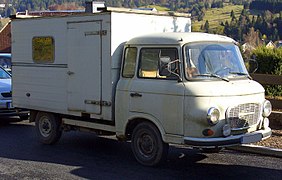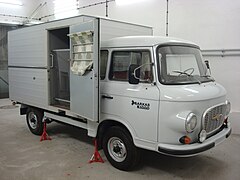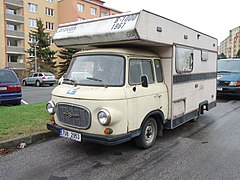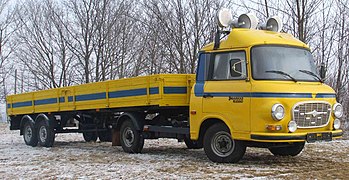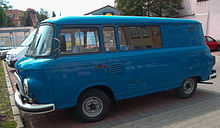Barkas B 1000
| Barkas | |
|---|---|
|
Barkas B 1000 panel van
|
|
| B 1000 | |
| Manufacturer: | VEB Barkas-Werke Karl-Marx-Stadt |
| Production period: | 1961-1990 |
| Previous model: | Barkas V 901/2 |
| Successor: | Barkas B 1000-1 |
| Technical specifications | |
| Designs: | Box vans , minibuses , flatbed trucks |
| Engines: |
Otto engine : 1.0 liter (34 kW) |
| Length: | 4520 mm |
| Width: | 1860 mm |
| Height: | 1850 mm |
| Wheelbase: | 2400 mm |
| Payload: | 1.0 t |
| Perm. Total weight: | 2.24 t |
The Barkas B 1000 was a small van that was manufactured in the years 1961–1991 at VEB Barkas-Werke Karl-Marx-Stadt . The one-tonne truck with a two-stroke engine was located above the Multicar and below the Robur LO in the GDR's production program . From 1990 it was produced as the B 1000-1 with a four-stroke engine under a VW license.
Development history
From 1954, systematic work was carried out on a completely newly developed small transporter under the designation "L1", as a study by the VEB IFA research and development plant in Chemnitz in 1951 showed the basic concept of the existing types to be completely outdated. In 1956 the first functional model of the L1 was built as a panel van. In 1961, the series production of the completely redesigned "Schnelltransporter" Barkas B 1000 began . At that time, the B 1000 was technically and formally state-of-the-art, as a comparison with the western vans of the time VW bus , Ford Transit , DKW Schnellaster , Tempo Wiking or Renault Estafette shows. The B 1000 took a top position, especially when it came to the chassis and the payload / cargo space factor. When it was first introduced in 1961, the transporter attracted attention due to the unusually high loading capacity of one tonne at the same time as its low loading height.
Facelift
Shortly after the start of series production, the displacement was increased from 900 to 1000 cm³, with the output increasing from 40 to 42 hp. In 1964 a number of technical improvements were made, including a dual-circuit brake system , stick gears instead of steering wheel gears, a modified cooling and heating system and improved seats. In 1969 the engine output was increased to 46 hp. As with many vehicles in the GDR, the further development of the small van came to a standstill from the mid-1960s, so that the B 1000 lost its connection to the international stand over the years. From 1984 an LED display for tank content and cooling water temperature was installed. The side flap door on the closed versions was replaced by a sliding door from June 1987. 175,740 vehicles of the B 1000 were built.
technology
The Barkas B 1000 was one of the few consistent new developments that went into series production in the GDR automobile industry. With the self-supporting body for the closed B-1000 vehicles, the frame construction of the V 901/2 was abandoned (from 1965 there were also bodies in frame construction). The B 1000 was powered by a Wartburg three- cylinder two-stroke engine , the displacement of which was initially 900 cm³ and later 1000 cm³. The performance in the Barkas was slightly lower than in the Wartburg in favor of a higher torque due to changes to the exhaust and intake system, it was initially 40, 42 hp, from 1969 it was 46 hp. Numerous other components have also been adopted from the Wartburg or other types for reasons of standardization. The gearbox, on the other hand, was redesigned, and unlike the Wartburg, the steering of the Barkas was initially designed as a worm gear (later recirculating ball steering gear ). The engine of the front-wheel drive vehicle was installed in the middle between the driver and front passenger seats and was accessible from inside the vehicle via a small service cover. The maximum permissible speed was 95 km / h, from 1969 100 km / h. During test measurements in 1962, fuel consumption varied between 10.7 l / 100 km when driving purely on the motorway with a 500 kg payload and 14.4 l / 100 km with a full payload when driving in low mountain ranges. The chassis, with independent suspension and torsion bar suspension, was comparatively advanced for a van.
Test reports
In test reports by the KFT from 1963 and 1964, it was initially praised that the B 1000 was both functional and elegant, and overall a modern vehicle. The comparatively small two-stroke engine with a displacement of only 1 l was defended by the fact that, with its torque of 9.8 kpm (96 Nm), it was on par with much larger four-stroke engines . Special praise went to the chassis, which offered cornering stability comparable to that of a car and very good suspension properties. The top speed of 103 to 110 km / h was well above the factory specification. The lack of fifth gear, the difficult steering wheel gearshift after a cold start, the rear wheels breaking out when the brakes were applied hard, a stiff handbrake and defects in the welded joints on the bodyshell were criticized, which however no longer occurred in 1964. Furthermore, a tendency to roar in the passenger compartment was criticized, the need for a flatbed variant was affirmed and warnings were given to the fact that the number of units was still too low. The calculated average fuel consumption was 9 to 12 l / 100 km, depending on the load.
Superstructures
Initially, the B 1000 was produced exclusively as a box, post office and ambulance. In 1964, a station wagon was added that was fully glazed and equipped with two or three rows of seats. The self-supporting body of the B 1000 was progressive, but only allowed a limited variety of bodies. For this reason, from 1965 onwards, versions were supplemented with a frame construction, including platform trucks and box bodies . As a result, the number of variants enlarged greatly, some of the B 1000 was prepared as standard parallel with over 40 different structures, including as a minibus, police car, ambulance the SMH , Klein pumper type KLF-TS_8 , trailer vans, truck tractors and military vehicle. Versions in which the vehicle was mainly used for passenger transport received a gasoline-powered auxiliary heater. The SMH 3 from 1985 onwards differed quite significantly from the other box bodies of the B 1000 in that it had a raised roof and a tailgate that opened upwards. Apart from the special features of the respective bodies, there was always only one standard equipment.
gallery
Stasi prisoner transporter in the Berlin-Hohenschönhausen memorial
B 1000-1
The first Barkas B 1000-1 was presented in autumn 1989 , and series production began in 1990. Like the Wartburg 1.3, it had a 58 hp four-stroke engine with 1272 cm³, the one from Barkas under VW license ( VW EA111 ) in the engine factory was produced in Karl-Marx-Stadt . Originally it was planned to redesign the look of the Barkas transporter with four-stroke engine. The front section was to be modernized with a large molded part made of plastic that combined the headlights and the radiator grille. Some prototypes were built. However, the new front design was no longer effective in series production. 1900 of these vehicles were built until production was discontinued on April 10, 1991.
When it was decided to stop production, the project to relocate production to Russia arose . Everything was packed, documented and provided with Russian translations by the former production managers. After the production documentation and the machine systems had been brought up to date for around four million DM , everything was packed in 40 large containers. However, several investors jumped out, ultimately none of them could afford the transport costs to Russia. On January 10, 1994, the project was declared a failure. The trust then scrapped everything. This is how a traditional vehicle production ended; 2,300 people were unemployed at the various production sites.
Availability
Small vans were extremely scarce in the GDR - even more so than cars. The production capacities of the modern Barkas B 1000 could not even cover the demand abroad until the 1970s. For private use in the GDR, it was difficult to get hold of a Barkas, even with older used vehicles. When decommissioning company-used vehicles, priority was given to families with many children or families with disabled relatives. For reasons of planned economy , production could not be increased or the price adjusted. An obstacle to efficient production was the economic classification of the B-1000 production and the sometimes more than 40 different superstructures offered. Even the gradual outsourcing of body-in-white production between 1985 and 1986 did not lead to increased production output. With the expansion of VEB Barkas-Werke into a highly complex large-scale operation, tasks other than the production of the B 1000 were in the foreground. Only a few thousand vehicles rolled off the assembly line each year. The highest annual number of units in B-1000 production was reached in 1974 with 8,176 units and a total of 175,740 units in the entire construction period. In addition to the B 1000, the Polish pickup truck Żuk was therefore temporarily available in the GDR . This convinced with a comparatively powerful engine, but it had a very high fuel consumption. In terms of workmanship and design, it could not keep up with the B 1000. However, these were considerations of a theoretical nature, since the demand for vans was generally high. A third pickup truck that was temporarily imported to alleviate the shortage of vehicles was the Romanian TV . A relevant quantity of the VW T3 also ended up in the GDR via Genex .
Prototypes
B 1100
As early as 1969 there was a promising and already well advanced prototype project for Barkas, which was ultimately stopped due to a lack of economic power and kept secret until the fall of the Berlin Wall. The three prototypes built between 1969 and 1972 are now in the Frankenberg Vehicle Museum in Saxony.
The model would have been perfectly suitable for securing the connection to the international production of small vans, the core idea here being the switch from the two-stroke to the four-stroke engine. For reasons of cost, the only engine that could be used was a unit from socialist production. A first attempt to install a Dacia engine from Romania in the existing B 1000 quickly made it clear that the cost was higher than designing a completely new vehicle. The prototype B 1100 was created. It was designed for a payload of 1300 kg and should reach a top speed of 120 km / h. Calculations showed that this required a minimum output of 75 hp. The automobile plant in Eisenach was there at that time one of developing new 1.6-liter four-cylinder four-stroke inline engine , but talked with information, so overcast that the designers of the Barkas no longer received as a few drawings to the external dimensions of the motor. The only suitable engine that was available at the time with a corresponding output was the 1500 cc light alloy engine of the new Moskvich-412 .
A total of three prototypes were built; two of them were equipped with a Moskvich engine, one got a Wartburg engine. After 30,000 km had already been covered with the vehicles, the project at Barkas and the engine project in Eisenach were ended in 1972. The prototypes were supposed to be destroyed, but were hidden by employees and only came to light again after the fall of the Wall.
Electric barcas
In the 1970s, in the wake of the oil crisis, various attempts were made to equip the B 1000 with an electric motor . The pick-up truck appeared to be a suitable vehicle for this purpose, especially in short-distance use. A corresponding electric barca was developed at the TU Karl-Marx-Stadt from 1972. Seven vehicles were tested in action at the Deutsche Post and the Deutsche Reichsbahn , among others, and they had an operating range of 100 km. Later, among others, the private small entrepreneur Schöps from Dresden experimented with lead-acid batteries as an energy source; he equipped a B 1000 with a three-axle chassis of a recovery vehicle with them. In all such tests it turned out that the development of the electric drive had not progressed sufficiently to produce sufficiently light and fast vehicles with a sufficient radius of action.
literature
- B 1000 express transporter - a new development from VEB Barkas-Werke. In: Automotive Technology . 11/1961, pp. 468-471; 12/1961, pp. 504-507; 2/1962, pp. 70-74; 3/1962, pp. 107-113; 4/1962, pp. 140 and 12/1962, pp. 516-519.
- Jürgen Lisse: Vehicle Lexicon Framo / Barkas . Bildverlag Böttger GbR, Witzschdorf 2008, ISBN 978-3-937496-23-8 .
- Günther Wappler: Framo & Barkas - The history of the 2-stroke vans from Saxony . WMS-Werbung Thum, 2005, ISBN 3-931770-63-X .
Web links
- www.barkas.de
- Website for the 4-stroke Barkas B1000-1
- Frankenberg Vehicle Museum
- Barkas B 1000 small fire engine ( Memento from April 9, 2012 in the Internet Archive )
Individual evidence
- ↑ Once a top concept with old technology in FAZ from September 25, 2012, page T4.
- ↑ The new B 1000 - key figure comparison with similar panel vans from the international automotive industry. In: Motor vehicle technology 12/1961, pp. 504–507.
- ↑ Barkas Kombi - new variant for a variety of purposes. In: Motor Vehicle Technology 3/1964, pp. 100-103.
- ↑ Successful standardization. In: Automotive Technology . 8/1962, p. 345.
- ↑ Test results from the development of the B 1000 vehicles. In: Automotive Technology . 5/1962, pp. 199-203.
- ↑ Motor vehicle technology tested Barkas B 1000. In: Motor vehicle technology . 9/1963, pp. 344-347.
- ↑ Automotive technology assesses Barkas B 1000 Kombi. In: Automotive Technology . 10/1964, pp. 378-379.
- ↑ Barkas Kombi - new variant for a variety of purposes. In: Motor Vehicle Technology 3/1964, pp. 100-103.
- ^ Peter Kirchberg: Plastics, sheet metal and planned economy. Nicolai-Verlag, p. 630.
- ^ Peter Kirchberg: Plastics, sheet metal and planned economy. Nicolai-Verlag 2000, pp. 631-632.





